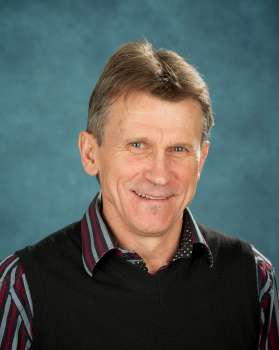
April 14, 2016
Professor Peter Herman of The Edward S. Rogers Sr. Department of Electrical & Computer Engineering has received a major grant from the Natural Sciences and Engineering Research Council (NSERC) worth $1.65 million over six years.
The Collaborative Research and Training Experience (CREATE) grant is designed to help train teams of highly qualified students and postdoctoral fellows from Canada and abroad. This funding advances Professor Herman’s work on developing more efficient data transfers for cloud computing.
Herman’s research focuses on materials and techniques to control the flow of light. This includes fibre optics, which revolutionized telecommunications in the 1980s by replacing metal wires with faster, more efficient light-conducting fibres.
“Today, that same story is being played out in the data centres that power cloud computing,” said Herman. “Electronic cabling is becoming a bottleneck, and the wires can only be packed so closely before signals are interfering. If you can switch it over to optical, it will reduce the cost and allow more information to flow.”
Optics have many other applications as well: optical sensors are used to monitor bridges, pipelines and even airplane wings, providing feedback on when they need to be repaired or replaced. Optics also enable ever-smaller medical probes that can image the inside of the body and reduce the need for invasive surgery. In this way, guided light underpins the connectivity that will support the Internet of Things, a connected network of everyday devices, from clothing to appliances to vehicles, that can send and receive data.
Herman is leading a team that includes Professors Stewart Aitchison (ECE), Joyce Poon (ECE) and Li Qian (ECE), as well as collaborators at Université Laval, and Quebec’s Institut national de la recherche scientifique (INRS). The team also includes several crucial researchers from Friedrich Schiller University Jena, a German research university.
“Jena is a world-leading place for optics research and manufacturing — they call it the City of Light,” said Herman. “We want to introduce our students, early on in their graduate studies, to the successful model they use to build links between academia and photonics companies. We will then follow up in Canada with links to Canadian optics industry.” The experience will help the students learn how to translate their discoveries into new products, either for existing companies or commercial ventures that they themselves will create.
Professors Herman and Milica Radisic (IBBME, ChemE) were the two CREATE recipients from the University of Toronto. Radisic and her team focus on growing realistic human tissues outside the body. With the latest announcement, there are now eight CREATE grants active across U of T Engineering.
“Professors Herman and Radisic are leading innovative programs that address key challenges in communications technology and human health,” said Professor Ted Sargent, vice-dean of research in the Faculty of Applied Science & Engineering. “This support will help us nurture a new generation of engineering leaders who can bring solutions from the laboratory into the marketplace.”
With files from Tyler Irving.
This story originally appeared on U of T Engineering News.
More information:
Jessica MacInnis
Senior Communications Officer
The Edward S. Rogers Sr. Department of Electrical & Computer Engineering
416-978-7997; jessica.macinnis@utoronto.ca